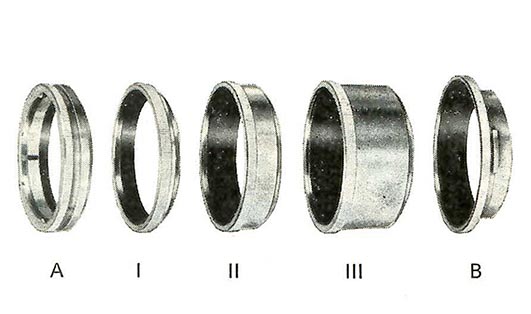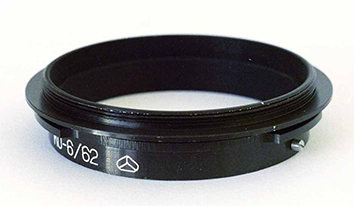by TRA
How can I mount an old lens on the Pentacon Six?
Q: “Hello, I have a lens with M66 screw mount without any helicoid or tube, which I want to adapt to P6 mount. Do you know by a chance who can make such thing with helicoid, etc? Thank you!?”
A: One of the advantages
of the SLR design is that it is possible to mount certain
old lenses onto the camera. Before you start, you
need to make sure of two things:
- that the lens is designed to cover the frame size of the Pentacon Six, i.e., a minimum of 54mm × 54mm
- that the lens will focus on infinity when it is mounted on the Pentacon Six. The Pentacon Six has a register distance between the front flange of the camera and the film plane of 74.1mm, and to this you must add the space that you will need for the focussing mount that you plan to make or buy. If you needed 60mm, say (to pick a random number), then you would need to be sure that the lens would focus on infinity when it was 60mm + 74.1mm from the film plane (in this example, 134.1mm). Many large, old lenses are designed to focus on infinity at a far greater distance than this, so you would have no problem.
Then you need two things:
- a Pentacon Six lens mount
- something to focus the lens.
Getting
a Pentacon Six lens mount
The easiest and cheapest way to get a Pentacon Six lens
mount is to probably get the shortest Pentacon Six
extension tube, which will give you a Pentacon Six mount
for much less cost than having one manufactured. You
can see the automatic Pentacon Six tubes here.
However, I would suggest that you get a manual tube, not an automatic one. That is to say, one of the older tubes, originally manufactured for the Praktisix, since you will not have any use for the automatic aperture pin that is in the automatic tubes when using your old lens , and the aperture pin in an automatic tube might in any case cast a shadow on the image. The problem of the shadow can be seen here.

[mantubb.jpg]
The manual tubes consist of a tube with a female Pentacon
Six mount ("A" in the above image), to receive the lens
and a tube with a male Pentacon Six mount ("B" in the
above image), to fit onto the camera. Each of these
two tubes has a screw thread on the other end and so they
can be screwed together. To achieve closer focus,
the distance between them can be increased by adding one
or more spacer rings ("I", "II" and "III" in the above
image). What you would require for this project
would be the item labelled "B" in the above image.
You can find more information on manual Pentacon Six tubes and pictures of them here.
On the main page on tubes (here), as well as the automatic Pentacon Six tubes you can also see the manual Arsenal (Ukrainian) tubes for the Kiev 60, which will also fit the Pentacon Six. The shorter of the Arsenal manual tubes might do the job. However, the manual Arsenal tubes are not often seen, and in any case, even the shorter of the two tubes might be too long for your purposes.A simple alternative source for a Pentacon Six lens mount could be the Arsenal reversing ring. This has a Pentacon Six mount at one end and a male 62mm×0.75 screw thread at the other.

The Arsenal reversing ring
[C370_21Asl.jpg]
You would then need a ring that would go between whatever camera mounting ring you were using (e.g., Pentacon Six manual ring "B", the Arsenal reversing ring, or something else) and the rear of your lens. You could buy a ring to join the two up, or have one made, to screw your chosen mount to the back of your lens. If you can't find a suitable ring available, I would suggest that you contact SRB in England, or an alternative engineering workshop that specialises in precision manufacture of small items. They may have a suitable ring, or could make one for you. See http://srb-photographic.co.uk/specialist-manufacture-1065-c.asp As well as the diameter of each thread (the one on the rear of the lens and the one on the front of your chosen camera mounting ring), they will also need to know the pitch of the thread at each end and whether the thread is male or female. The inside of any such ring should be matt black, to prevent any reflections, which would seriously degrade the quality of the image.
Getting a focussing mechanism
To obtain focus, the cheapest way would be to mount your
lens (joined to a Pentacon Six lens mount via a suitable
ring) onto the standard Pentacon Six bellows, which have a
minimum extension of just 19 mm. They are often
offered on-line and are not usually expensive. These
will provide focus, and you will be able to achieve
infinity focus with many old lenses designed for larger
formats, for which the register distance to the rear of
the lens was quite large. If you do not want to use
bellows, SRB or a similar manufacturing workshop could
probably make a focussing tube for you. The simplest
design would probably have one tube within another, with a
screw thread that had a fairly coarse (i.e., wide)
pitch. Again, the inside of any such focussing
tube(s) should be matt black.
I hope that these ideas will help you.
Best regards
"Mr Pentacon Six"